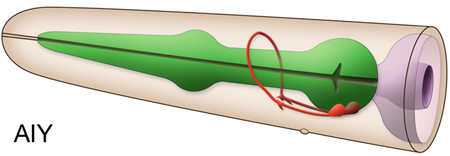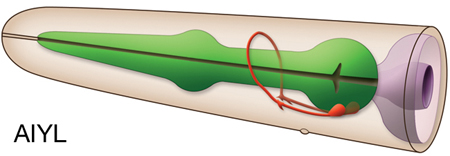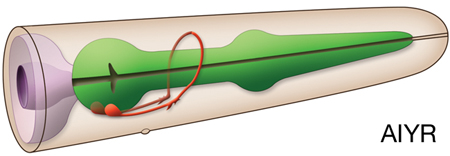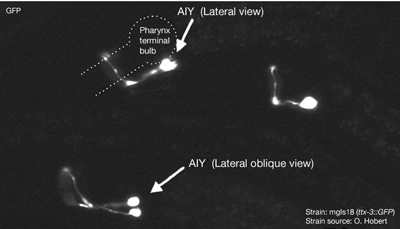
|
|
|
 
|
AIYL, AIYR
Type: Interneuron
In MoW: AIY
In WormWiring:
AIYLh,
AIYRh,
AIYLm,
AIYRm
In Wormbase: AIY, AIYL, AIYR
Lineage: AB plpapaaap, AB prpapaaap
Location: Ventral ganglion in the head
Description: Amphid interneurons. The process of each AIY neuron enters the nerve ring from the ventral side. After running dorsally within the nerve ring, it meets its contralateral partner at the dorsal midline and makes a gap junction with it
Neurotransmitter/ Neuropeptide:
- Acetylcholine
- FLP-1; FMRFamide-like peptide
- FLP-18; FMRFamide-like peptide
(Li and Kim, 2008;
Rogers et al., 2003; Altun-Gultekin et al., 2001)
Innexin expression:
- INX-1
- INX-7
- INX-19
- UNC-9
(Altun et al., 2009; Chuang et al., 2007)
Receptor expression:
- ACR-14; nicotinic AChR alpha subunit
- C50F7.1; tachykinin receptor-like
- CKR-2; cholecystokinin receptor-like
- GAR-2; muscarinic AChR
|



|
- GCY-1; transmembrane receptor guanylate cyclase
- GLC-3; L-glutamate-gated chloride channel subunit (ionotropic glutamate rec subunit)
- LAT-1; predicted latrophilin
- LGC-38; GABA-gated chloride channel
- MGL-1; metabotropic glutamate receptor
- MOD-1; serotonin receptor (serotonin-gated Cl- channel)
- NPR-11; candidate receptor for NLP-1
- NPR-14; tachykinin receptor-like
- SER-2; tyramine receptor (two separate splice variants)
- SRA-11; G protein-coupled seven transmembrane receptor
(Wormbase; Altun, 2011; Chalasani et al., 2010; Ortiz et al., 2006; Wenick and Hobert, 2004; Tsalik et al., 2003; Altun-Gultekin et al., 2001; Troemel et al., 1995)
Function: AIYL/R is one of the four first layer amphid interneuron pairs (AIA, AIB, AIY, and AIZ) that receive and process synaptic output from the amphid sensory neurons. They are
postsynaptic to several olfactory and gustatory sensory neurons, such as ASE, ASI, AWA, AWC and AFD, and are
presumed to play an integrative role, processing multiple streams of sensory information. They have a key role in behavioral plasticity in paradigms in which starvation is paired with a thermal or chemical cue (de Bono and Maricq, 2005; Ishihara et al., 2002).
- Functions in thermotaxis; laser ablation of the AIY pair makes the animals cryophilic and impaired in isothermal tracking (Mori and Ohshima, 1995). The thermal information sensed by AFD, AWC and ASI is processed in downstream interneurons AIY, AIZ, RIA ( thermotaxis core interneurons) and also likely in AIA and AIB (Ma and Shen, 2012; Sasakura and Mori, 2012; Ardiel and Rankin, 2011; Beverly et al, 2011). In the original two-drive model of thermotaxis, activation of AIY neuron-signaling drives warm-seeking (thermophilic) movement, activation of AIZ neuron-signaling drives cold-seeking (cryophilic) movement, while the counterbalancing between the AIY and AIZ signals, possibly through the RIA interneuron, leads to execution of motor output in response to thermal signals. (Ohnishi et al, 2011; Kuhara et al, 2008).
AIY is the major postsynaptic partner of AWC and AFD. AWC-derived glutamatergic signals stimulate AIY and induce migration to warmer temperature (Ohnishi et al, 2011). AFD transmits both inhibitory and stimulatory signals to AIY such that calcium concentration threshold in AFD acts as a switch for opposing neural signals to AIY that direct opposite (warm- or cold-seeking) behaviors (Kuhara et al., 2011). AFD-derived glutamatergic signals inhibit AIY through activation of GLC-3 glutamate-gated chloride channel and drive migration towards colder temperature. Recent studies suggest
this AFD/AIY synapse may have evolved for reliable transmission of a scaled-down temperature signal from AFD, enabling AIY to monitor and integrate temperature with other sensory inputs (Narayan et al, 2011). The molecular mechanism of the stimulatory signaling between AFD and AIY is currently unknown.
- Functions in locomotion: Suppresses turns and reversals enhancing smooth forward movements and dispersal, since laser ablation of AIY increases reversals and turns, disrupts dispersal behavior and shortens forward movements (Gray et al., 2005; Wakayabashi et al., 2004 ; Tsalik and Hobert, 2003). Similar to AIY, laser ablations of ASE or AIA increases the frequency of reversals while ablations of AWC, AIB or AIZ decreases the frequency of reversals (ablation of RIA does not affect turning rate). Since ablations of AIY and AIZ (the major postsynaptic partner of AIY) cause opposite behavioral phenotpes, the synapses made by AIY onto AIZ may be inhibitory. Alternatively, signals fom AIY to AIZ are processed in a downstream neuron such as RIA (de Bono and Maricq 2005).
- Functions in information processing within the AWC-AIB-AIY circuit that controls food- and odor-evoked behaviors (Chalasani et al., 2007). AWC neurons are activated by food or odor removal and activate theAIB interneurons through AMPA-type glutamate receptors, while they inhibit AIY interneurons through glutamate-gated chloride channels; odor presentation relieves this inhibition and results in activation of AIY interneurons. The opposite regulation of AIY andAIB interneurons generates a coordinated behavioral response.
- Regulates lifespan and starvation response (starvation induces heat-shock resistance, oxidative stress resistance and extension of life-span). Certain amino acids (such as leu, gln, ala, val, ile) might act as signaling molecules that modulate the starvation response by acting as anti-hunger signals. The amino acid signal activates AIY neurons and inhibits AIB neurons by modulating the activities of MGL-1 and MGL-2 metabotropic glutamate receptors in these neurons, respectively. AIY then inhibits the starvation response, whereas AIB activates it (Shen et al, 2010; Kang and Avery, 2009). |
 Click pictures for higher resolution images Click pictures for higher resolution images
 |
IDENTIFICATION:
The three neurons, AIM, AIY and AVK resemble pearls-on-a-string, located posterior and slightly more superficial to the excretory cell nucleus on the right and left sides of the head.The nucleus of the excretory cell is the biggest one on the ventral side, below the terminal bulb of the pharynx and looks like an egg with a sunny-side-up appearance. The three neuronal nuclei can easily be located immediately posterior to the excretory cell nucleus, the most anterior one being AIM, the middle, AIY, and the most posterior one, AVK. On the right side, sometimes RIS nucleus accompanies these three nuclei.Cell and axon structures of AIY and AIM are very similar; care must be taken to differentiate between the two when identifying these two cells with fluorescent markers.
|
|
Click here for larger version
AIYL (AB plpapaaap) development in the embryo. Dorsal view. Bottom is left side of the embryo. Spheres indicate individual nuclei. Black sphere: ancestors of AIYL; dark grey spheres: apoptotic cells; other cells follow the WA color code (after they acquire specific cell or tissue identities). 0 min is fertilization. Click on the movie for higher resolution rendition (by A. Santella & Z. Bao). |
Click here for larger version
AIYR (AB prpapaaap) development in the embryo. Dorsal view. Bottom is left side of the embryo. Spheres indicate individual nuclei. Black sphere: ancestors of AIYR; dark grey spheres: apoptotic cells; other cells follow the WA color code (after they acquire specific cell or tissue identities). 0 min is fertilization. Click on the movie for higher resolution rendition (by A. Santella & Z. Bao). |
|

Last revision: November 20, 2012 |


